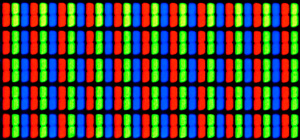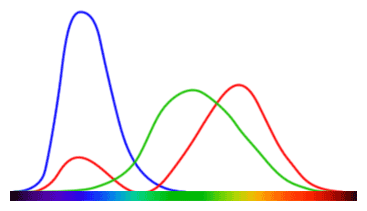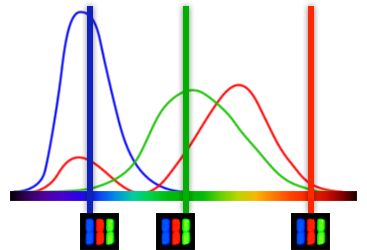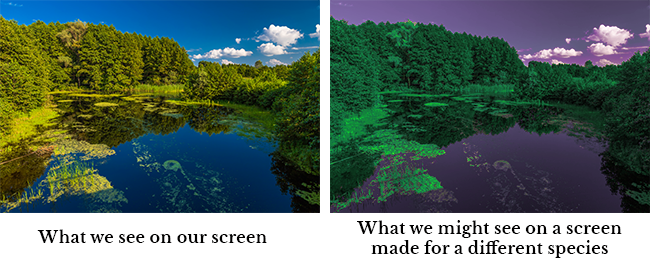When an animal sees a computer screen, it doesn’t see the same colours as you do because our monitors only properly work for humans. This article will explain why.
You have probably heard that computer screens consist of tiny dots, called pixels, and that each pixel has a colour composed of three “elementary” colours: red, green, and blue. To do that, each pixel consists of three smaller “dots” that shine in different colours. A typical close-up of an LCD screen looks as follows:

Do you see how always one red, one green, and one blue bar form a square? That’s a pixel, the smallest dot you can see on your screen. You cannot see the little colour bars with the naked eye; modern computer screens have such a high resolution that the only way for us to see them is to use some sort of magnifying glass.
When seen from a normal distance, the LCD screen shown above looks uniformly white. How is that possible? Due to an illusion. An illusion that only perfectly works for humans, not for animals.
Three colours for three cones
To understand how computer screens work, we have to first understand our own eyes. The electromagnetic spectrum is a continuous range of wavelengths, only a tiny part of which is visible to humans:
We see neither the ultraviolet wavelengths and shorter, nor the infrared wavelengths and longer. How do we see the rest? We have three types of colour-sensitive cells in our eyes, the so-called cones.
The cones do not perceive just a single colour. They are activated by a whole range of colours, and the signals received from the cones are then processed by the brain in such a way that every spectral colour can be thought of as composed of three different elementary signals:

Note that this chart does not show the spectral properties of the cones themselves (but they look similar). It represents the CIE 1931 colour space, which, simply put, corresponds to the signals after they have been processed by the brain.
For example, when you see yellow light, both “green” and “red” signals are activated, but your brain knows that “a lot of red activation and a little bit less green activation” represents yellow, so in your mind you see yellow.
Screen manufacturers use the way our brain composes colours out of just three different types of signal to trick our brain into seeing colours that are “not there”. Screens emit light of just three different colours at approximately the following wavelengths:

Of course, computer screens are not lasers, so they do not emit just a single wavelength but a broader range of wavelenghts. Nevertheless, the picture above will allow us to understand what actually happens.
Screens combine red, green, and blue light with varying brightness to create the same combination of red, green, and blue signal in the brain as different colours (like “cyan”, “yellow”, etc.) do. This tricks the brain into believing that it sees a colour that is not present in the picture at all.
This all has to be carefully calculated. Blue light produces a blue and red signal in the brain, green light produces a green and red signal, and even red light produces a little bit of green signal. To produce a colour like yellow, you have to take green light and add the correct amount of red light to have more red than green in the correct ratio in the resulting signal.
Animals need not apply
The slightly shocking thing about all this is: Monitors are based on an optical illusion that it specific to humans. Other animals do not share the same spectral properties of cones; they do not even share the same number of cones. Dogs possess only two types of cones, many birds have four, and the mantis shrimp has 16!
If you show a digital photo to your pet, it will most likely see something that, in terms of colours, looks very different not only from what you see, but also from what it would see if it saw the real object. Just to get an idea of what other species might see, I tried to simulate what a human could see on a screen made for a bird.
Birds can see ultraviolet light but only little red light. Pictures on a bird screen would be strangely violet due to a source of violet light accommodating their “ultra-violet” cone. Greens would probably look rather bluish due to the fact that their “green” cone is between green and blue in the spectrum. There would also be no red. All in all, we might see something like this:

What we should realize is that when an animal looks at a human screen (or a printed document, for that matter, because printing is also based on composition of colours), they will see something similarly diverging from what they see in the real world. They still see the same shapes, but the colours may be completely off. I wonder whether scientists who study cognitive abilities of animals by showing them pictures even realize that…
 Tip: Are you a non-native English speaker? I have just finished creating a
Tip: Are you a non-native English speaker? I have just finished creating a  Web App
Web App
